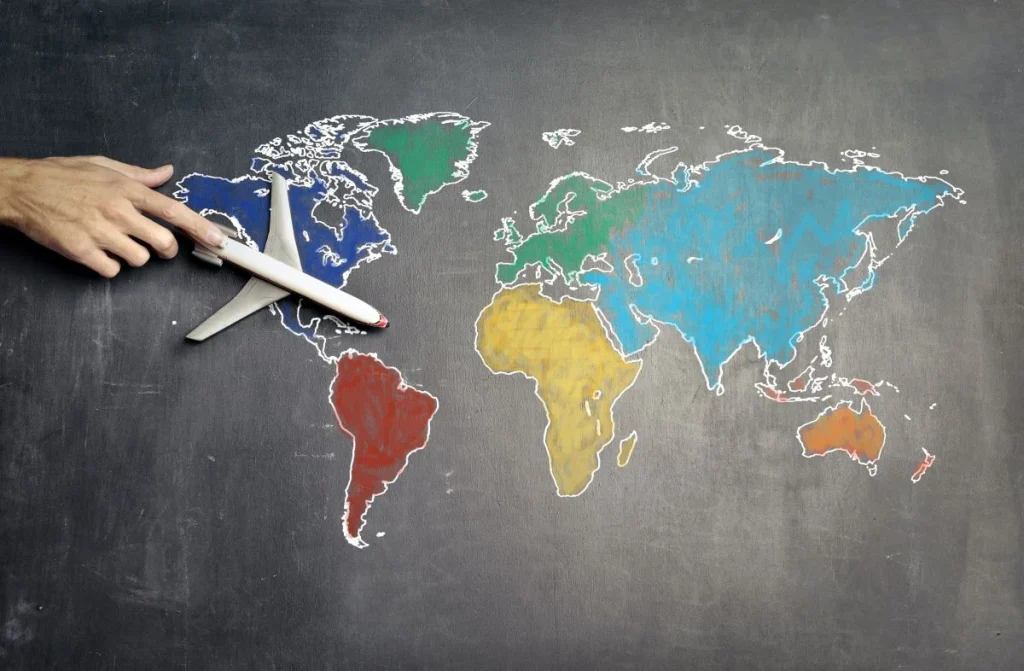The traditional methods of sending and receiving money from overseas are rapidly evolving as a result of technological advancements and the integration of financial systems. This development has benefited the millions of people who depend on remittances and provided several opportunities for regional companies and banking institutions. This change in remittances and payments offers more effective and secure payment options for real estate property for sale and investments, making it particularly relevant for cross-border real estate properties and investment activities.
What is Global Remittance Landscape?
The term “global remittance landscape” refers to the transfer of monies from one country or region to another across international borders, frequently from migrants’ or foreign employees’ home countries. This landscape includes a wide range of financial institutions, technologies, rules, and market dynamics that affect how remittances are sent and received.
Remittances Providers

Financial institutions, money transfer operators (MTOs), and online marketplaces that enable the transfer of money from one place to another, frequently across international borders, are referred to as remittance providers. These companies provide services that let people and companies send money to people and organizations overseas.
- Financial institutions, money transfer operators (MTOs), and online marketplaces that facilitate the movement of money from one place to another, sometimes across international borders, are referred to as remittance providers. These companies provide services that let people and companies transmit money to people and businesses overseas.
- MTOs are businesses that focus on international money transfers. Receivers in various areas can pick up cash easily because of their frequently extensive network of agent locations. MTOs include, among others, Ria Money Transfer, MoneyGram, and Western Union.
- Many online and mobile apps have appeared to offer practical and affordable services for international remittances. Examples include Venmo (for peer-to-peer transfers), PayPal, Revolut, and TransferWise (now Wise).
Recipient Nations
In the global remittance landscape, recipient countries are those that get money from other countries’ remittances. In order to support their families and loved ones back home, migrants, expatriates, foreign workers, or other people living abroad typically send these funds. These recipient countries’ economies and general well-being may be significantly impacted by remittances. Foreign workers and immigrants who transmit money to their families back home frequently send remittances. These people frequently have a big impact on the world remittance scene.
Foreign workers and immigrants who transmit money to their families back home frequently send remittances. These people frequently have a big impact on the world remittance scene.
Digital and Mobile Solutions

In the contemporary financial landscape, including the remittances sector, mobile and digital solutions are increasingly important. By enhancing accessibility, convenience, and cost-effectiveness, these technologies have completely changed how people send and receive money. Many developing nations have seen an increase in popularity of mobile money services like M-Pesa in Kenya and GCash in the Philippines. Customers can send and receive money, pay bills, and make purchases using their mobile devices by storing money in a mobile wallet connected to their phone number.
Users can store payment information and conduct transactions using their smartphones or other digital devices with the help of digital wallets like PayPal, Apple Pay, Google Wallet, and Samsung Pay. Online purchases and international remittances are both possible with these wallets. The remittance industry could be completely changed by the use of blockchain technology and cryptocurrencies like Bitcoin. They provide a decentralized and safe way to send money across borders, possibly lowering costs and speeding up transactions.
Marketplace rivalry
Market rivalry and competition among different financial institutions, money transfer companies, fintech firms, and other providers of remittance services are referred to as “remittances” in the context of market competition. The desire to gain customers by providing better rates, lower fees, quicker transaction times, and improved services is what fuels this competition.
Consumers gain from market competition because it lowers prices, boosts the caliber of services, and promotes innovation. Customers now have a larger selection from which to choose and can pick the remittance provider that best suits their unique requirements, whether those requirements relate to cost-effectiveness, speed, convenience, or access to particular recipient locations. In order to remain relevant in a changing market, providers are also encouraged by this competition to constantly improve their offerings.
Remittance Dynamics Across Borders

Technology has been crucial in reshaping this landscape over the last ten years. Cross-border remittances are now more streamlined, affordable, and accessible thanks to innovations in mobile money, blockchain technology, and fintech startups. Numerous opportunities are presented by this transformation in numerous industries.
The socio-economic structure of the Asia-Pacific region depends heavily on cross-border remittances. Remittances from relatives living abroad help millions of families in nations like India, the Philippines, and Vietnam pay for their daily expenses, send their children to school, and save for the future. However, the traditional remittance channels, like banks and money transfer companies, have a reputation for having expensive fees, protracted transaction times, and volatile exchange rates.
Societal, Economic, and Technological Advancements Are Affected by Various Factors

Economic Factors
Labor migration is influenced by economic inequalities between nations. In countries with stronger economies, migrants frequently look for better employment opportunities. These people make up a sizable portion of cross-border remittances, regularly sending money back to their home nations.
Remittances heavily depend on exchange rates. The amount that the recipient receives can change depending on fluctuations in currency values. Both the sender and the receiver may occasionally experience financial uncertainty as a result of these rate changes. Remittance patterns are also influenced by the opportunities and economic stability in the recipient country. Remittance flows may decrease during economic downturns as migrants experience job losses or decreased income abroad.
Dynamics of remittances can be significantly impacted by the cost of sending money across borders. People may turn to alternative, possibly riskier methods of remittance as a result of high fees and hidden costs that discourage them from using formal channels.
demographic and social factors
- Family Support: Social and familial factors are frequently major drivers of remittances. Money is frequently sent by migrants to support the daily needs of their families, such as education, healthcare, and living expenses.
- Gender Dynamics: Female family members frequently serve as the main recipients of remittances, using the money to manage the finances of the home and provide for the education of their children.
- Healthcare and Education Costs: A sizable portion of remittances is used to pay for healthcare and education costs. The recipient countries’ development may benefit in the long run from this assistance.
Regulatory Framework
To prevent money laundering and ensure the tracability of funds, governments and regulatory bodies have established rules. By influencing the selection of channels and methods for sending money, these regulations can affect the dynamics of remittances. By limiting who can offer remittance services, licensing and compliance regulations have the potential to influence both competition and service quality in the remittance industry.
By limiting who can offer remittance services, licensing and compliance regulations can affect the competition and level of service in the remittance sector.
Technical Developments
- Fintech and Digital Platforms: The remittance industry has undergone a revolution thanks to technological developments like mobile money and digital platforms. These developments have made it simpler, quicker, and more affordable for people to send and receive money internationally.
- Blockchain and cryptocurrencies: New technologies like blockchain and cryptocurrencies are gaining popularity in the remittance industry because they provide safe and cost-effective transactions.
- Mobile banking has become a common way to send and receive remittances, especially in areas with little access to traditional banking services due to the widespread use of mobile phones and the internet.
Regulatory Framework
To prevent money laundering and assure the traceability of funds, governments and regulatory bodies have set guidelines. By influencing the selection of channels and techniques for transferring money, these restrictions might affect the dynamics of remittances.
By limiting who can offer remittance services, licensing and compliance regulations can affect the competition and level of service in the remittance sector.
Opportunities for Fintech Businesses
The constantly changing financial services sector offers a wide range of prospects for fintech (financial technology) businesses. Fintech firms might look into new prospects as technology advances and consumer preferences shift. Cross-border remittance-focused financial startups have exploded in the Asia-Pacific area. These businesses use cutting-edge technology to speed up the procedure and provide customers a convenient, affordable substitute for conventional banking practices.
- Cost savings: When compared to banks and money transfer businesses, fintech startups are frequently able to offer reduced transaction fees. Both remittance senders and recipients could save billions of dollars as a result of this. With the move to digital payments, payment processors, mobile wallets, and peer-to-peer payment networks all have opportunities for innovation. Fintech businesses may provide solutions that are safe, practical, and simple to use.
- The use of digital platforms and blockchain technology enables almost immediate transactions, greatly lowering the amount of time it takes for money to arrive at its destination. As cryptocurrencies become more popular, fintech companies can develop services for trading, wallet management, and blockchain applications. A fast expanding subset of this topic is decentralized finance (DeFi).
- Robo-advisors: For automated investment management, robo-advisors are gaining popularity. Fintech firms can provide investors with more advanced algorithms and individualized solutions.
- Financial planning, investment tracking, and budgeting are all areas where fintech companies can create apps and platforms. Users can utilize these tools to make well-informed financial decisions.
- Cybersecurity: As financial transactions become more digital, there is a rising demand for effective cybersecurity solutions. To protect customer data and assets, fintech companies can create sophisticated security procedures.
In order to take advantage of these opportunities while ensuring that they continue to be secure and compliant, fintech companies should keep an eye on changing regulations, client expectations, and developing technologies. Since the fintech industry is extremely competitive, success depends on innovation and customer-centric strategies.
Government and Regulators

Governments can use these modifications to encourage financial inclusion by ensuring that groups that are underserved and unbanked have access to cost-effective and secure remittance services.
The government can develop and modify regulatory frameworks to suit the fintech industry’s rapid expansion. This entails establishing precise regulations and standards for diverse fintech industries while fostering innovation. It can create and implement consumer protection laws to guarantee the security and safety of fintech consumers. Regulations governing data privacy, fraud protection, and dispute resolution procedures are included.
Regulators can use regulatory technology (RegTech) to speed up the processes involved in compliance and oversight. RegTech tools can aid regulators in more effectively monitoring and enforcing compliance. Governments can create frameworks for digital identities that offer citizens safe and practical means of proving their identity online. The development of digital services, especially finance, depends on this.
Cross-border fintech operations may benefit from international cooperation to develop unified regulations. International transactions may become more secure and effective as a result. By supporting initiatives and regulations that help underbanked and unbanked communities get access to the financial system, governments can leverage fintech to promote financial inclusion. To increase transparency and lessen the burden of human reporting, encourage financial institutions and fintech firms to adopt standardized and automated reporting procedures.
Encourage laws and standards for the moral application of AI in the finance industry, ensuring transparent algorithms and impartial decision-making. In order to ensure impartial decision-making and transparency in algorithms, promote rules and regulations for the moral use of AI in the financial industry. For the purpose of educating customers on the advantages and risks of fintech services, governments can fund financial literacy initiatives and awareness campaigns.
In the Asia-Pacific area, cross-border remittances are evolving as a result of and in response to the shifting financial environment. Governments, conventional banks, and fintech startups can all profit from these shifts. Millions of people who depend on remittances stand to benefit from this transition with lower prices, improved efficiency, and greater accessibility. Additionally, companies and financial institutions that adapt to these developments can take advantage of a dynamic and expanding market, stimulating innovation and regional economic growth. The changing remittance landscape in Asia-Pacific is a spur for improvement in a number of industries, not only finance.
Related Blog: Why Are Foreign Firms Keen on Investing in the Philippines


